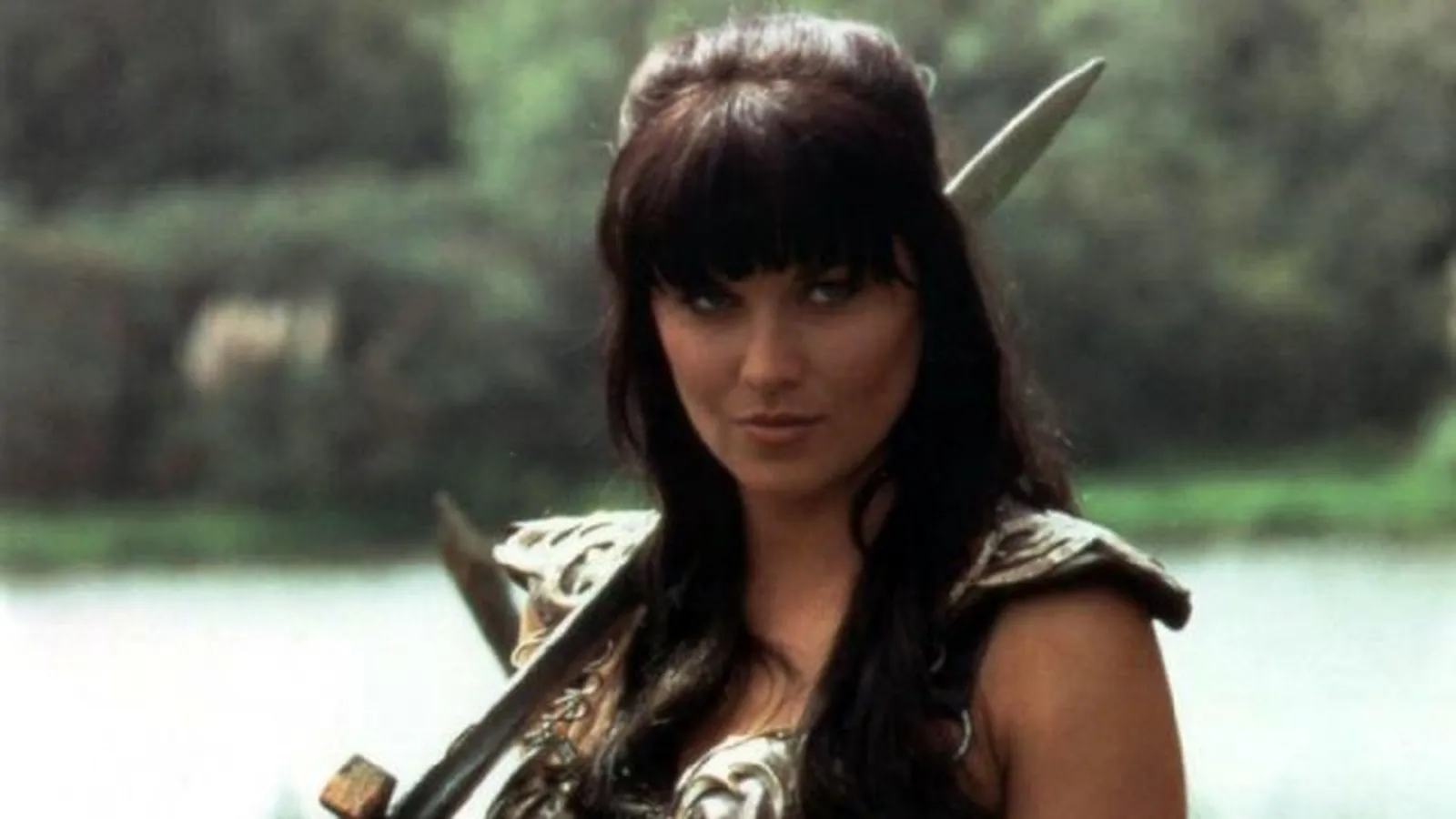Twenty Years Later, a Look at How Xena: Warrior Princess Changed Television

In a time of cheesy special effects, girl power and syndication, a brave heroine overtook the pop culture landscape. She was Xena, a mighty princess forged in the heat of nineties feminism and her courage changed the world. In light of the recent 20th anniversary of the premiere of Xena: Warrior Princess in syndication (on September 4, 2015), and news of a Xena reboot on NBC, it’s a perfect time to look back on the legacy of a show that changed pop culture forever.
Girl Power
Before Buffy the Vampire Slayer back-flipped onto the scene in 1997, there was Xena. The character first debuted in season one of Hercules: The Legendary Journeys, but she wasn’t just a generic chick-in-some-boob-armor, of which the Hercules franchise already had many (one of which was actually played by Xena herself, Lucy Lawless … there aren’t a lot of actors in New Zealand). From the get-go, Xena was complex and multifaceted. She was introduced as a villainous warlord to whom Hercules showed the error of her ways, but once she hit her own show, she rapidly became much more. She was sexy, smart, dangerous, and flawed. Add in Lawless’ incredible charisma, and you had a hit.
Xena was the kind of heroine no one had really seen on TV for a long time, if ever. Sure, the show was campy, and with her whip and Betty Paige bangs, she pinged a few fetish bells, but she also kicked ass unapologetically. This was an awesome action hero who happened to be a lady—something that’s still rare and precious. Just seeing her on television was empowering and inspiring for girls and women everywhere, and Xena became an instant sensation. The runaway success of the warrior princess blazed a trail for all the Buffys, Sydney Bristows, Starbucks, and Peggy Carters that would follow by proving how awesome, and successful, a female hero could be.
That Other Land Down Under
Both Hercules and Xena were filmed and produced in New Zealand, which at the time was perhaps the only thing most American pop culture connoisseurs knew about the small nation. The show made amazing use of the country’s varied and beautiful landscape years before another production took over the island chain: a little movie called The Lord of the Rings. The success of Xena was also the success of the New Zealand film industry, something that continues to this day, not only for New Zealand as a filming location but in the careers of the Kiwi actors that got their start on Xena, such as Karl Urban, Martin Csokas, Craig Parker, and Lucy Lawless herself.
Raimi the Mighty
Xena didn’t just save Greece and New Zealand; she saved superhero movies. Really. Xena (and Hercules) were bound to be cult classics because they were brought into the world by a directing/producing team that, at the time, was known for bloody, weird movies with cult followings. Rob Tapert and Sam Raimi, along with Xena regular Bruce Campbell, were not household names when Hercules got off the ground, but they were a great team with the right experience and the perfect silly-scary aesthetic that, mixed with some action, a perfect lead, and some gay subtext, made Xena their biggest success. When Xena wrapped in 2002, Raimi rode that success into another franchise you might have heard of called Spider-Man and helped revive and reinvent the blockbuster superhero genre (after the increasingly horrible efforts of the ’90s), the rewards of which we are still reaping today.
The X Factors
Xena was also one of a few ’90s shows that started the trend towards a different way of telling stories for television. Following in the footsteps of The X-Files, Xena proved the viability of telling longer serialized stories in genre TV. Long-form storytelling over multiple episodes or even seasons was new back in the day and had only seen limited success in the past. Because of Xena, we got Buffy, but those shows also laid the foundation for Lost (where long-time Xena stunt double Zoe Bell made an appearance) and Battlestar Galactica (featuring, that’s right, Lucy Lawless).
Xena (and Hercules as well) was also one of the first shows to get really meta. The fourth wall was broken time and time again as the show created its own mythology about … itself, in episodes like “The Xena Scrolls.” It was one of the first television shows to portray and poke fun at its own fanbase in creative ways, paving the way for shows like Supernatural to elevate meta-episodes to an art form.
It was even the first show to do a musical episode. Xena was in some ways able to do this because it was syndicated (for those kids that don’t know, this meant it was made by a production company but not supported by a specific network, instead bought by various second tier networks). Not being subject to network scrutiny gave the show a certain creative freedom. As the creativity and genre fare of syndicated shows like Xena became more popular, we saw it more on network and cable television and also saw the slow extinction of syndicated television after Xena’s final battle cry.
Gals Bein’ Pals
The speculation that Xena and her trusty sidekick, Gabrielle, might be more than friends wasn’t necessarily new territory for television (after all, the same question had been asked of Kirk and Spock for decades) but this was the nineties, when attitude towards LGBTQ issues were rapidly evolving, Ellen had just come out, and even the idea that a famous TV character might even subtextually gay was still big news. The thing that made Xena special was that the writers almost immediately became aware of the following devoted to Xena and Gabrielle’s relationship and began inserting subtext and sly hints all around that they were, indeed, lovers. To this day, Xena is a lesbian icon. By the end of the series we knew the two women were soul mates, literally, and were married in a different life, but we never actually heard that either Xena or Gabrielle themselves were bisexual.
Telling a gay love story through subtext is now a time-honored TV tradition—one many shows are still following. In the case of Xena coming out, as it were, and explicitly saying that the Warrior Princess was queer was not seen as a viable option even in 2002 when the show ended. In 2015, it certainly is, and yet very few shows that are telling gay love stories in subtext have been able to move that story to main text, leading many fans to lament these shows are simply baiting queer audiences. Whether or not that’s true is a very tricky question, but the success and subversiveness of subtext for Xena provided a template for many shows after it.
Girls Just Wanna Have Fun
Xena was not highbrow entertainment, but it was a damn fun and entertaining show, and that’s perhaps its greatest legacy. It reminded us of what genre TV can do best: be many things. It was epic, subversive, funny, serialized, gay, dramatic, feminist, violent, campy and emotional all at once, and that was great. It was part of a rockslide in the nineties that started the avalanche of the golden age of television we are still enjoying.
And that’s how a little camp syndicated show managed to change television forever.
Jessica Mason is a writer and lawyer living in Portland, Oregon. More of her writing can be found at www.fan-girling.com, and follow her on Twitter at @FangirlingJess.
—Please make note of The Mary Sue’s general comment policy.—
Do you follow The Mary Sue on Twitter, Facebook, Tumblr, Pinterest, & Google +?
Have a tip we should know? tips@themarysue.com
